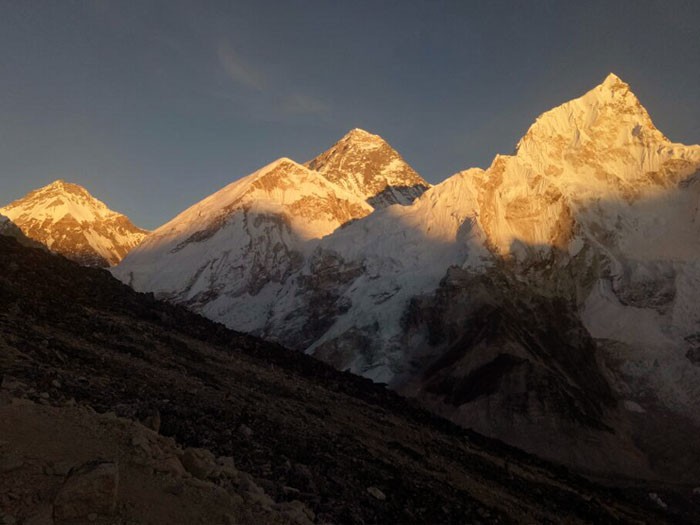Acute Mountain Sickness (AMS)
Parts of your trip go above 2800 metres / 9200 feet where it is common for travelers to experience some adverse health effects due to the altitude - regardless of your age, gender and fitness. It even happened to Sir Edmund Hillary!
Before your trip:
Some pre-existing medical conditions are known to severely worsen at high altitude and be difficult to adequately treat on the ground, leading to more serious consequences. It is imperative that you discuss your pre-existing medical condition/s with your doctor. We understand certain medications are reported to aid acclimatizing to high altitude. Please discuss these options with your doctor.
During your trip:
While our leaders have basic first aid training and are aware of the closest medical facilities, it is very important that you are aware of the cause and effects of travelling at altitude, monitor your health and seek assistance accordingly.
Altitude Sickness (AMS)
Parts of your trip go above 2800 meters / 9200 feet where it is common for travelers to experience some adverse health effects due to the altitude - regardless of your age, gender and fitness. It even happened to Sir Edmund Hillary!
What is it?
Altitude sickness is the reaction of the body adjusting to decreasing amounts of oxygen. Normally, the higher the altitude, the less oxygen available for the body to carry on normal functions. Altitude sickness most commonly occurs from above 2,800 metres (9,200 ft) but this is different for everyone - there is simply no way of knowing your own susceptibility prior to being at altitude thus it is vital you monitor your own health. Symptoms may be mild and subside/go away after a day’s rest, or if it is ignored it could lead to death.
Symptoms of altitude sickness…
Symptoms can appear within 1-2 hours although most often appear 6-10 hours after ascent and generally subside in 1-2 days as the body adjusts to altitude. They may reappear as you continue to go higher. Symptoms usually occur gradually & can be one or a combination of the following:
- Headache
- Loss of appetite
- Disturbed sleep or drowsiness
- Irritability
- Fatigue
- Nausea/vomiting
- Dizziness
- Swelling of hands, feet & face
If the body is unable to adjust to altitude these symptoms will persist and, if they are left untreated, altitude sickness may progress to
High Altitude Cerebral Edema (HACE) or High Altitude Pulmonary Edema (HAPE). Both can be fatal if ignored.
Symptoms of HAPE (fluid on the lungs):
- Breathlessness
- A dry cough, developing to a wet one with blood-tinged discharge or saliva.
- Tightness in the chest & blueness/darkness of face, lips & tongue
- Low fever up to 38°C/100°F
- Severe fatigue, progressing to coma
- HAPE can occasionally develop without the usual symptoms of AMS - a telltale sign is breathing does not return to normal when at rest, it remains shallow, rapid and panting even after an extended period of inactivity, often accompanied by a cough.
- Symptoms of HACE (fluid on the brain):
- Severe headache symptoms not relieved by painkillers or lying down
- Confusion, disorientation & drowsiness
- Nausea/vomiting
- Loss of balance or coordination
- Blurred or double vision/retinal haemorrhage
We recommend you to keep track of altitude related symptoms you may experience by completing the below chart from the first day you experience any altitude sickness symptoms. If you are experiencing any altitude sickness symptoms, we encourage you to discuss them with your leader straight away so you both can follow your acclimatisation progress. However, should you ratethe severity of any symptoms at 7 or more, or the symptoms continue/worsen after the initial 1-2 days, please inform your leader without delay, so that we can seek the advice of a trained medical professional if necessary.
Everyone will have a different perception of the severity of their symptoms, the key is to personally assess whether your symptoms are improving or worsening. A rough guide would be:
How to avoid altitude sickness?
Certain medical conditions (such as respiratory disease) or medications (such as sleeping pills) can increase the risk of altitude sickness, it is important that you inform your guide/leader of any medical conditions or medications before ascending to altitude. You can help your body to acclimatize and avoid altitude sickness by:
• Drinking plenty of water - at least 4 liters per day on top of other forms of fluids such as tea or soups
• Avoiding alcohol, tobacco and substances that can interfere with good delivery of oxygen to the body or cause dehydration.
• Eating small, frequent meals high in carbohydrates.
• Taking it easy or have a regular break. Walk at a slower pace than you would at sea level and avoid over-exertion.
Treatment…
Most travelers are able to successfully acclimatize by following the previously mentioned guidelines. However, there are instances where medical treatment is required. Ultimately, the best treatment for acute altitude sickness is to descend to a lower altitude. There may be times when your guide/leader makes the decision that you or a member of your group is at risk of serious altitude sickness and for safety insists that you cannot ascend further - please respect that they are within their rights to do so and are making that decision in the best interests of your health and well-being.




